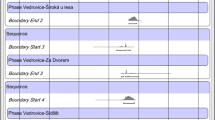Abstract
Serris-Les Ruelles is an early medieval demesne (manor house) showing the bipartite structure which is typical of this kind of landed property. The organisation is based on social difference: on the one hand the lord in his manor house, on the other the peasant in their village. The difference is apparent from the inorganic remains. Two out of four possible criteria were applied to investigate whether the difference is also apparent in plant food. The result of the investigation was negative. The reason might be that the spatial and economic separation between lord and peasant was not yet wide enough where food was concerned.
Similar content being viewed by others
References
Foucray B, Gentily F (eds) (in press) “Les Ruelles” de Serris, village et nécropole du haut Moyen-Age
Greig J (1988) Plant resources. In: Astill G, Grant A (eds) The countryside of medieval England. Blackwell, Oxford, pp 108–127
Haaster H van (1991) Umwelt und Nahrungswirtschaft in der Hansestadt Lübeck. Lübecker Schr Archäol Kulturgesch 21: 203–222
Hingh AE de, Bakels CC (in press) “Les Ruelles” de Serris, agriculture et alimentation. In: Foucray B, Gentily F (eds) “Les Ruelles” de Serris, village et nécropole du haut Moyen-Age
Montanari M (1993) La fame et l'abbondanza: storia dell'alimentazione in Europa [hunger and plenty: history of food in Europe]. Laterza, Roma
Paap N (1983) Economic plants in Amsterdam: qualitative and quantitative analysis. Brit Archaeol Rep Int Ser 181: 315–325
Paap NA (1984) Palaeobotanical investigations in Amsterdam. In: Zeist W van, Casparie WA (eds) Plants and ancient man. Balkema, Rotterdam, pp 339–344
Ruas MP (1988) L'agriculture. In: Un village au temps de Charlemagne. Editions de la Réunion des musées nationaux, Paris, pp 203–213
Ruas MP (1992) The archaeobotanical record of cultivated and collected plants of economic importance from medieval sites in France. Rev Palaeobot Palynol 73: 301–314
Shepherd RW (1924) Historical atlas. Barnes and Noble, New York
Speller A, Buchez N, Dareau I, Gentili F, Danion B (1994) A la découverte d'un terroir. Archéol 305: 26–39
Vandommele H (1991) Van kapucijner tot doperwt [from marrowfat peas to green peas]. Stichting Mens en Cultuur, Gent
Zeist W van, Woldring H, Neef R (1994) Plant husbandry and vegetation of early medieval Douai, northern France. Veget Hist Archaeobot 3: 191–218
Author information
Authors and Affiliations
Rights and permissions
About this article
Cite this article
de Hingh, A., Bakels, C. Palaeobotanical evidence for social difference? The example of the early medieval domain of Serris-Les Ruelles, France. Veget Hist Archaebot 5, 117–120 (1996). https://doi.org/10.1007/BF00189441
Received:
Accepted:
Issue Date:
DOI: https://doi.org/10.1007/BF00189441



